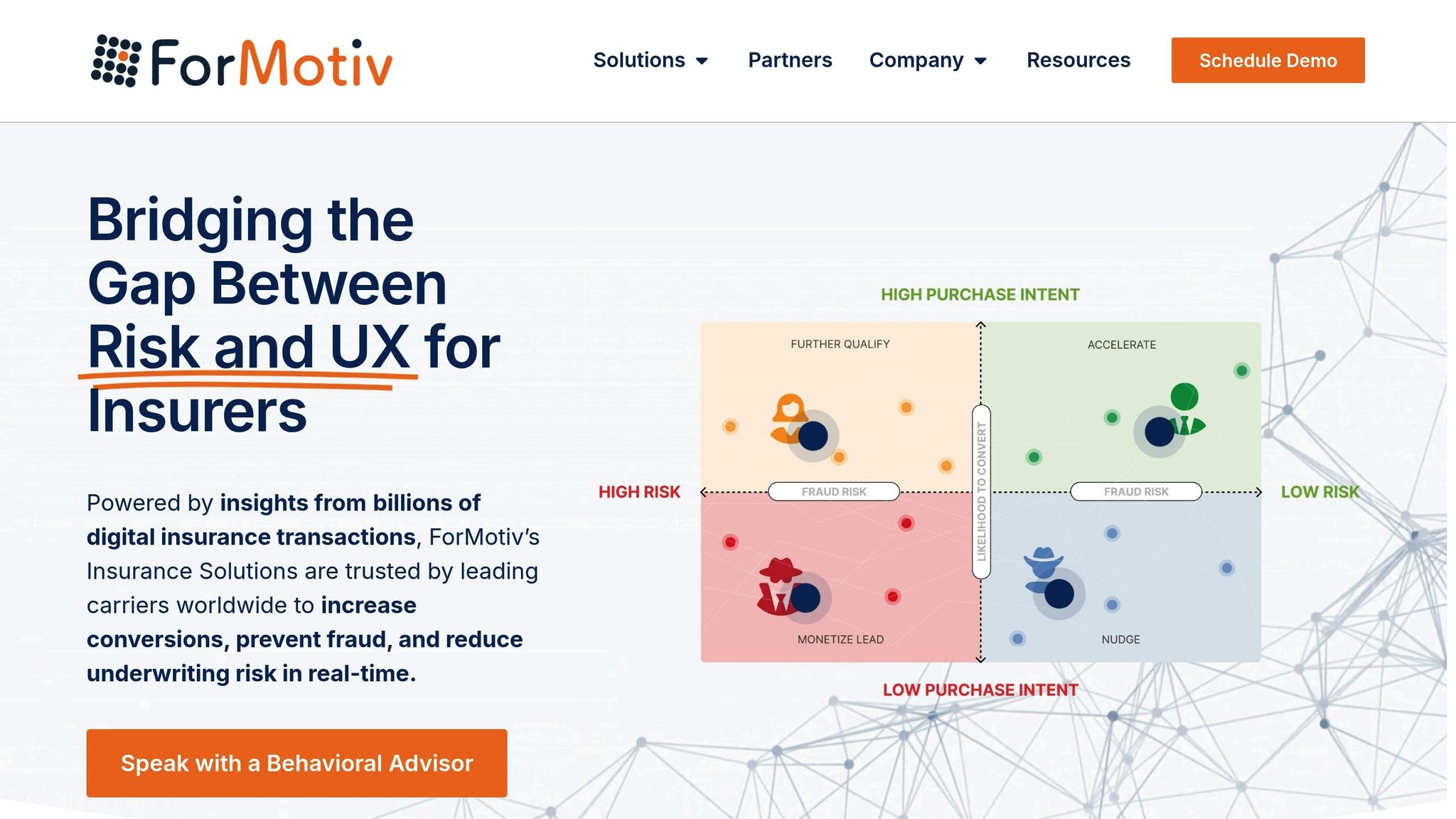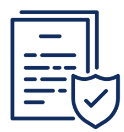Insurance companies lose billions annually to premium leakage. This happens when policyholders underpay, misrepresent details, or commit fraud – whether intentionally or due to system flaws. In 2022 alone, U.S. property and casualty insurers lost $29–$36 billion, with commercial insurers seeing $8 billion in losses. These costs impact everyone, raising premiums by an estimated $400–$700 per family each year.
Key takeaway: Traditional methods like audits are too slow and inefficient. Data-driven tools, such as behavioral analytics, offer real-time insights to detect risks early. For example, platforms like ForMotiv analyze user behavior during applications (e.g., hesitation, corrections) to flag potential issues before policies are issued. This proactive approach helps insurers reduce leakage, improve underwriting accuracy, and lower costs for policyholders.
Quick Overview:
- What causes premium leakage? Misrepresentation (e.g., mileage, garaging location), hidden drivers, and outdated systems.
- Impact: Up to 10% of insurer losses and higher premiums for consumers.
- Solution: Behavioral analytics for real-time risk detection, targeting issues like rate evasion and fraud during the application process.
Behavioral analytics isn’t just a tool – it’s a necessity for insurers aiming to protect revenue and ensure fairness for honest customers.
Behavioral Patterns That Cause Premium Leakage
Common Problem Behaviors
Understanding the behaviors that lead to premium leakage is crucial for insurers aiming to protect their revenue.
Intentional misrepresentation is a major contributor. A 2012 survey found that 16% of consumers admitted it was acceptable to lie about their mileage to an insurer[2]. This type of misrepresentation results in staggering losses: over $5 billion annually from underreported mileage, nearly $3 billion from false garaging claims, and $16.5 billion related to misrepresented driver risks[2].
Hidden driver scenarios are another source of leakage. Research from Verisk shows that 12% of standard policies and 15% of nonstandard policies may involve "hidden" drivers[2]. When these drivers are eventually added to policies, the delayed reporting can cost insurers more than $1,000 in premium per case[2].
"That ‘hidden’ driver may have a very different risk profile from named drivers."
- Alan Tinney, Assistant Vice President of Auto Sales, Verisk Insurance Solutions[2]
Business use misrepresentation is another issue, with over 10% of personal lines policies affected by underreported commercial vehicle usage[2]. Similarly, misrepresentation of vehicle ownership is prevalent, and policies with ownership inaccuracies tend to have loss ratios that are more than double the average[2].
Life event changes also contribute significantly to premium leakage. As policyholders experience changes – such as moving, acquiring new vehicles, or adding drivers – many fail to report these updates promptly. Research indicates that 40% of policies undergo such changes annually, yet many are either delayed or completely unreported[2].
Agent-influenced behaviors further exacerbate the problem. Some agents intentionally guide applicants to provide inaccurate information to secure lower rates, creating systematic misrepresentation that amplifies industry losses[2].
Recognizing these behaviors is the first step in understanding why traditional detection methods often fall short.
Why These Patterns Are Hard to Detect
The sheer complexity and volume of these behaviors make them difficult to identify using traditional methods.
Geographic complexity is a significant hurdle. For example, Verisk estimates that garaging misrepresentation costs insurers $32.5 million annually in lost premiums in Miami alone[2]. Additionally, their client model analysis revealed that more than 10% of policies contained errors in garaging addresses[2].
Timing delays further complicate detection. Traditional audits often occur too late, as shown by an average 13.6-month delay in adding new drivers, leaving insurers unable to capture real-time changes[2].
Subtle behavioral cues – like hesitation or repeated changes in application forms – can signal misrepresentation, but these are often too nuanced for human reviewers to catch consistently.
Data fragmentation is another obstacle. Insurers must piece together information from motor vehicle records, professional licensing databases, and vehicle registration data. Manually connecting these disparate sources is both time-consuming and error-prone.
This is where ForMotiv’s real-time behavioral analytics comes into play. By monitoring how users interact with digital application forms, ForMotiv identifies patterns – such as hesitation or frequent edits – that may indicate misrepresentation. These insights allow insurers to flag high-risk applications during the process, rather than months later during audits.
ForMotiv also addresses timing issues by providing instant feedback. This enables underwriters to verify suspicious applications before policies are issued, preventing revenue loss from the outset.
"Insurers that don’t make strategic use of granular analytics may not survive the next decade as they assume and retain underperforming business while losing high-potential, lifetime policyholders."
- John Mullen, retired CEO, Direct General Insurance[2]
How Behavioral Analytics Prevents Premium Leakage
Using Behavioral Data in Insurance
Behavioral analytics plays a key role in identifying premium leakage by analyzing applicants’ digital behaviors. This method captures subtle patterns – like hesitation or corrections – that traditional methods often miss.
ForMotiv’s platform, for example, collects over 5,000 behavioral data points per application. These include factors like typing speed, pauses, mouse movements, keystrokes, corrections, and time spent on specific questions. Together, these elements create a "behavioral fingerprint" that can reveal potential risks. For instance, an applicant hesitating before answering a question about their driving history or repeatedly correcting their address could signal underlying issues.
ForMotiv quantifies customers’ digital body language – hesitation, cognitive load, frustration, confusion, keystrokes, idle time, mouse movements, copy/paste, corrections – and links these to potential risks such as misrepresentation and fraud. [6]
The impact of this approach is striking. A major life insurance provider discovered that 72% of applications required multiple corrections after submission, a clear red flag for potential leakage risks [6]. When comparing traditional and modern methods, the difference is even more apparent: traditional risk assessments typically analyze around 20 variables, achieving a prediction accuracy of 67.3%. In contrast, modern behavioral analytics evaluates over 1,000 variables with an accuracy of 89.4% [7]. ForMotiv also uses historical behavioral patterns to build predictive models, which can identify misrepresentation before a policy is even issued [6].
These detailed insights allow insurers to take action immediately, bringing real-time risk detection into the spotlight.
Real-Time Risk Detection
The ability to detect risks in real time gives insurers a significant edge. Traditional audits often fall behind, leaving insurers vulnerable to losses [2]. ForMotiv’s system, however, flags issues like rate evasion, premium leakage, and eligibility concerns during the application process itself [3]. This proactive approach lets underwriters address potential problems before policies are finalized.
This capability is especially critical in today’s landscape, where application fraud has risen by 18% since 2019, and auto insurance premium leakage costs the industry an estimated $35.1 billion annually [5].
ForMotiv leverages advanced, real-time behavioral analytics to detect these risky behaviors and empowers you to intervene early in the application process, preventing leakage before it impacts your bottom line. [3]
ForMotiv‘s Premium Leakage Prevention Solutions

ForMotiv Platform Features
ForMotiv’s platform offers cutting-edge behavioral analytics designed specifically for insurance applications. It captures over 5,000 behavioral data points during each application process, creating a detailed "behavioral fingerprint" that highlights potential risks [3].
The platform’s API is lightning-fast, responding in under 20 milliseconds. This ensures instant risk assessments, allowing underwriters to make quick decisions without interrupting the customer experience. The API integrates seamlessly into existing workflows, combining signals, models, and DataPacks effortlessly [9].
At the heart of ForMotiv’s capabilities are its predictive AI models. These models analyze subtle patterns – like typing speed, hesitation, error rates, and cognitive load – to flag applications that may need closer inspection [8]. Additionally, tools like the Explorer and Behavioral Dashboards provide offline insights into applicant behavior, offering deeper understanding beyond real-time assessments [3].
Integration is simple and efficient, thanks to lightweight JavaScript code that captures behavioral data without slowing down performance. Crucially, ForMotiv ensures compliance with privacy regulations by not collecting, storing, or transmitting any personally identifiable information (PII) [9].
The system excels at identifying rate evasion, premium leakage, and eligibility issues during the application process. By addressing these problems early, insurers can avoid lengthy and costly audits after policies are issued [3].
These advanced features deliver measurable results for insurers, improving both efficiency and accuracy.
ForMotiv Benefits for Insurers
ForMotiv significantly improves operational efficiency for insurers. With the ability to analyze over 1 billion auto insurance applications, the platform provides a solid foundation for precise risk assessment [3].
Real-time risk detection and automated triaging streamline workflows, allowing underwriters to focus on flagged cases. The platform also ensures full compliance with U.S. data privacy laws, including GDPR, CCPA, and PIPEDA, so insurers can enhance risk assessment without sacrificing customer trust or regulatory adherence.
One striking example of ForMotiv’s impact: a Top 10 Life insurer found that within just one month, 72% of their applications required agent corrections. This demonstrates the platform’s effectiveness in identifying high-risk submissions and improving data accuracy [10].
ForMotiv adapts effortlessly to various insurance types, making it valuable for auto, life, property, and commercial lines. Its versatility ensures insurers can address premium leakage across all areas of their business.
Solutions for Different Insurance Types
Premium leakage affects different insurance types in unique ways, and ForMotiv tailors its solutions to meet these specific challenges. The platform works seamlessly across direct and agent distribution channels, making it suitable for a wide range of business models [4].
In auto insurance, premium leakage is a major issue for property and casualty carriers. In 2022 alone, this problem cost carriers around $32 billion. Common issues include underreported mileage (affecting 60% of vehicles) and inaccurate garaging addresses (seen in over 10% of applications). ForMotiv also identifies hidden drivers, which are present in 12% of standard policies and 15% of substandard policies. This is critical, as policies with undisclosed drivers have loss ratios more than twice as high [10].
Life insurance applications benefit from ForMotiv’s ability to detect misrepresentations and agent manipulation. The platform analyzes applicant behavior, such as hesitation or corrections when answering health-related questions, to uncover potential undisclosed conditions.
In property insurance, ForMotiv evaluates applications for accurate property descriptions, occupancy details, and coverage needs. It flags inconsistencies or attempts to manipulate coverage terms, ensuring policies are based on accurate information.
For commercial insurance, where risks are often more complex, ForMotiv detects when business owners appear uncertain about their operations or try to downplay risks. This ensures proper underwriting for these intricate policies.
Across all insurance lines, ForMotiv’s Premium Leakage Solution identifies risky behavior and prioritizes applications for appropriate action during underwriting [10]. Insurers can dynamically adjust the customer experience – adding or reducing friction based on real-time behavior analysis. This approach not only addresses the $32 billion premium leakage problem in property and casualty carriers but also combats a 20% decline in application integrity over the past decade [10]. By balancing accuracy with efficiency, ForMotiv helps insurers tackle these challenges head-on.
To Catch a Thief: Explainable AI in Insurance Fraud Detection | Ville Satopaa & Antoine Desir
sbb-itb-ec84a5c
Practical Strategies to Reduce Premium Leakage
Premium leakage, a problem costing nearly $40 billion annually, calls for focused and systematic strategies to address the issue effectively [6]. Below are actionable approaches insurers can adopt to tackle this challenge using advanced analytics and targeted audits.
Adding Behavioral Analytics to Underwriting
ForMotiv’s real-time data insights offer insurers a way to manage risks proactively during the underwriting process. By incorporating behavioral analytics into underwriting workflows, insurers can improve risk assessment and identify instances of application manipulation [6]. Rule engines process complex datasets to flag potential risks early [6].
In auto insurance, telematics data – such as speeding, hard braking, and driving times – can be used to calculate personalized risk scores [11]. Here’s an example of how driving behavior impacts scoring:
| Driving Behavior | Criteria | Points |
|---|---|---|
| Speeding | 10-20% over speed limit | 5 |
| 20-30% over speed limit | 10 | |
| 30%+ over speed limit | 15 | |
| Hard Braking | 1-2 instances in a trip | 3 |
| 3-4 instances in a trip | 5 | |
| 5+ instances in a trip | 8 | |
| Night Driving | Driving between 12 AM – 4 AM | 8 |
Life and health insurers are also leveraging lifestyle data – such as exercise habits, smoking status, and BMI – to adjust premiums [11]. Initial rule sets assess key criteria, while detailed scorecards evaluate various factors. Healthier lifestyles may even lead to premium discounts [11].
ForMotiv’s real-time analysis further strengthens this process by flagging potential rate evasion or eligibility issues as they occur [6].
Focused Premium Audits
In addition to analytics-driven underwriting, targeted audits are a powerful tool to secure revenue by verifying flagged risks. Traditional premium audits can be time-consuming and may miss high-risk cases. However, using behavioral analytics risk scores allows insurers to focus audits on policies most likely to contain inaccuracies or fraud. By automating manual steps, these data-driven audits make the process more efficient [13].
For example, targeted audits in workers’ compensation cases have recovered up to 18% in additional premiums [16]. Effective audit strategies include:
- Verifying applicant information against external databases
- Using geospatial analysis to validate property details
- Scanning for suspicious patterns, such as frequent policy changes [13]
A major U.S. property and casualty insurer revamped its quote-to-issue process by integrating external data and predictive models, significantly cutting processing times [14]. ForMotiv’s behavioral risk scores further enhance audit efficiency by pinpointing policies that require closer examination, reducing surprises during post-issue audits.
Ongoing Monitoring and Updates
Continuous monitoring is essential for insurers to stay responsive to changing risk patterns. Real-time monitoring, powered by IoT devices and telematics, enables insurers to shift from static risk models to dynamic, prevention-focused strategies [12]. For instance, Allstate’s Drivewise program has shown that real-time feedback can cut the likelihood of severe collisions by 25% [12]. Similarly, AI-driven sensors have helped reduce water damage claims by nearly 25% [12].
Research also shows that using trusted data in underwriting can reduce processing times by 30–40% and lower operational costs by 15–25% [15]. Continuous monitoring allows insurers to adjust risk assessments based on actual behavior, keeping their models up to date [15].
ForMotiv supports this process with its behavioral analysis tools, helping insurers quickly identify shifts in risk patterns. This proactive approach is particularly critical since about 7% of life policies involve some form of non- or under-disclosure – a figure that rises to nearly 17% by the time claims are filed, costing insurers over $12 billion [6].
Conclusion: Solving Premium Leakage with Data
Premium leakage cost U.S. insurers between $29–$36 billion in 2022, adding around 14% to premiums. This staggering figure highlights the urgency for insurers to adopt data-driven strategies to combat revenue loss [1][19].
Key Points
Real-time behavioral analytics offers insurers a way to detect and address revenue risks as they occur, rather than waiting months or years for audit results. This proactive approach can significantly reduce financial losses.
ForMotiv’s platform analyzes over 5,000 data points in real time and has already identified revenue risks in over 1 billion insurance applications [3][18]. Its glass-box approach ensures transparency by providing data through real-time feeds or batch files while adhering to GDPR, CCPA, and PIPEDA regulations. Importantly, the system does not collect personally identifiable information [1][8]. By combining this first-party behavioral data with existing datasets, insurers can enhance their risk assessments without the high costs and limitations of third-party data sources [17].
Understanding behavioral patterns tied to nondisclosure – such as undisclosed smoking, which costs insurers $4 billion annually, or manipulated auto insurance applications – enables insurers to act preemptively. Incorporating behavioral analytics into underwriting workflows, conducting targeted premium audits, and maintaining continuous monitoring create a robust defense against revenue loss.
These strategies pave the way for insurers to modernize their operations and reduce leakage effectively.
Next Steps for Insurance Companies
To address premium leakage, insurers need to act decisively. Start by reviewing current processes and integrating advanced data tools. Updating legacy systems to centralize information and enable advanced analytics is a critical first step [20].
ForMotiv’s lightweight JavaScript integration provides immediate behavioral insights without compromising system performance [1][8]. By pairing existing records with ForMotiv’s behavioral data, insurers can refine client profiles, improve quoting accuracy, and enhance risk assessments [21].
Additionally, insurers should invest in training and recruit analytical talent to maximize the potential of behavioral analytics [22]. Automated reporting systems can track behavioral patterns and conversions, offering valuable insights into both applicant and agent behavior [21].
A well-rounded strategy includes investing in the right technology, maintaining compliance with data protection laws, and fostering a culture that prioritizes data-driven decisions [22]. Behavioral data triggers can also support customer service by flagging potential issues before they escalate into revenue losses [21].
With premium leakage accounting for up to 10% of an insurer’s loss and loss adjustment expenses, the cost of inaction far exceeds the investment in these solutions [1][19]. By adopting tools like ForMotiv’s behavioral analytics platform, insurers can not only recover lost revenue but also gain a competitive edge through better risk assessment and operational efficiency. ForMotiv’s streamlined platform ensures insurers stay ahead of risks while maintaining accuracy in underwriting practices.
FAQs
How does ForMotiv help insurers improve underwriting accuracy and prevent premium leakage?
How ForMotiv Transforms Insurance Underwriting
ForMotiv’s behavioral analytics platform gives insurers a powerful edge by analyzing real-time behavioral data during the digital application process. This technology picks up on subtle patterns that might indicate risks such as rate evasion, fraudulent activity, or discrepancies in eligibility. With this information, insurers can act quickly to address potential issues before they escalate.
With insights drawn from over 1 billion insurance applications, ForMotiv reveals hidden risks and malicious behaviors that traditional methods often overlook. The result? Reduced revenue losses, improved loss ratios, and more accurate underwriting decisions that help insurers operate more efficiently and effectively.
What unique behaviors can ForMotiv detect that traditional methods often miss?
ForMotiv’s platform focuses on uncovering digital body language – the small, often overlooked actions users take during the application process. These include things like typing speed, keystroke patterns, corrections, pauses, and other subtle digital interactions.
By analyzing these behaviors, ForMotiv delivers sharper insights into user intent. This helps insurers identify potential risks, reduce revenue loss, and make more accurate underwriting decisions based on actionable data.
How can insurers seamlessly integrate ForMotiv’s behavioral analytics into their current systems without disrupting operations?
Integrating ForMotiv’s behavioral analytics into your current systems is simple and designed to fit into your operations without causing disruptions. With the help of APIs and other integration tools, ForMotiv can easily plug into your existing applications. This means you’ll get real-time behavioral insights without the need for a complete overhaul of your workflows.
What’s more, ForMotiv is designed to align smoothly with your current infrastructure. By rolling out the integration in stages, insurers can keep their operations running as usual while gaining the benefits of more accurate underwriting and better detection of premium leakage. This step-by-step approach ensures the process is as seamless and stress-free as possible, tailored to fit your organization’s unique requirements.





